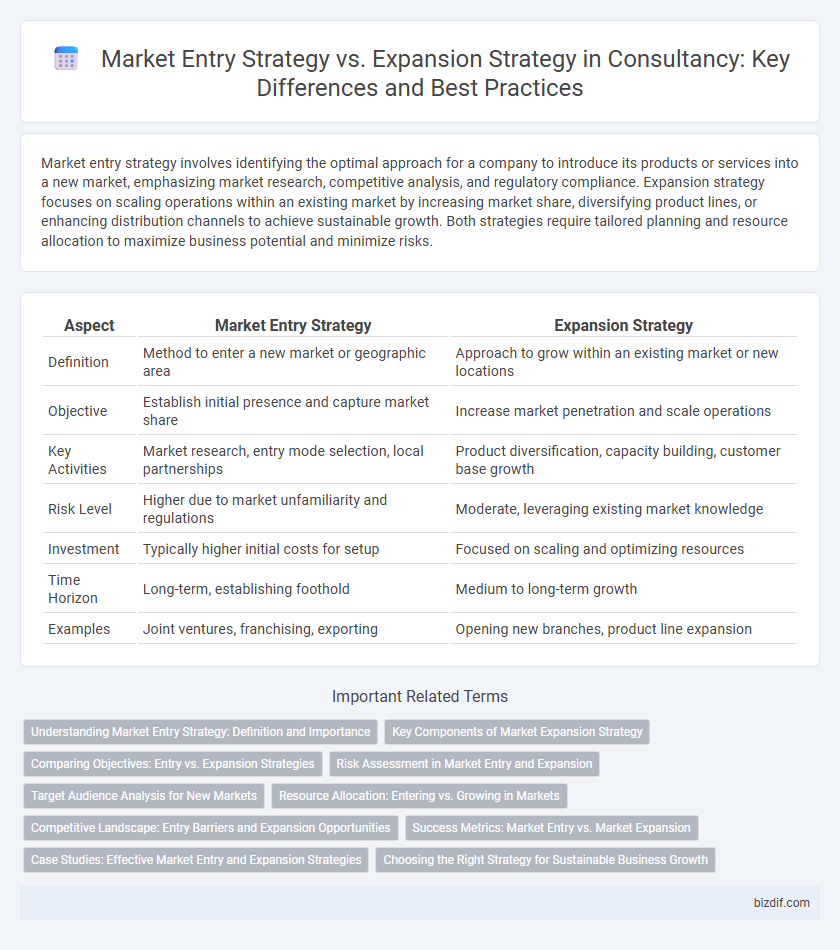Market entry strategy involves identifying the optimal approach for a company to introduce its products or services into a new market, emphasizing market research, competitive analysis, and regulatory compliance. Expansion strategy focuses on scaling operations within an existing market by increasing market share, diversifying product lines, or enhancing distribution channels to achieve sustainable growth. Both strategies require tailored planning and resource allocation to maximize business potential and minimize risks.
Table of Comparison
| Aspect | Market Entry Strategy | Expansion Strategy |
|---|---|---|
| Definition | Method to enter a new market or geographic area | Approach to grow within an existing market or new locations |
| Objective | Establish initial presence and capture market share | Increase market penetration and scale operations |
| Key Activities | Market research, entry mode selection, local partnerships | Product diversification, capacity building, customer base growth |
| Risk Level | Higher due to market unfamiliarity and regulations | Moderate, leveraging existing market knowledge |
| Investment | Typically higher initial costs for setup | Focused on scaling and optimizing resources |
| Time Horizon | Long-term, establishing foothold | Medium to long-term growth |
| Examples | Joint ventures, franchising, exporting | Opening new branches, product line expansion |
Understanding Market Entry Strategy: Definition and Importance
Market entry strategy involves the systematic planning and execution of introducing a product or service into a new geographical region or market segment, focusing on minimizing risks and maximizing competitive advantage. It encompasses critical decisions such as market research, selection of entry mode (e.g., joint ventures, franchising, direct investment), and adaptation to local consumer behavior and regulatory environments. Understanding market entry strategy is essential for businesses aiming to establish a foothold in unfamiliar markets, ensuring sustainable growth and long-term profitability.
Key Components of Market Expansion Strategy
Market expansion strategy involves identifying new customer segments, evaluating geographic regions, and adapting products or services to meet local needs, which are key components to ensure successful growth. It emphasizes competitive analysis, resource allocation, and scalable marketing tactics tailored to the targeted market's cultural and economic characteristics. Effective implementation depends on thorough market research, strategic partnerships, and continuous performance monitoring to minimize risks and maximize return on investment.
Comparing Objectives: Entry vs. Expansion Strategies
Market entry strategies primarily aim to establish a foothold in a new geographic or demographic market, focusing on brand introduction, customer acquisition, and regulatory compliance. Expansion strategies concentrate on scaling operations within an existing market to increase market share, optimize supply chains, and enhance customer loyalty. The key distinction lies in entry strategies targeting initial presence, while expansion strategies drive growth and operational efficiency in established markets.
Risk Assessment in Market Entry and Expansion
Risk assessment in market entry strategy involves evaluating political, economic, and competitive risks to determine market viability and mitigate potential losses. Expansion strategy risk assessment focuses on analyzing operational, financial, and regulatory challenges within established markets to sustain growth and avoid overextension. Both strategies require rigorous due diligence and scenario planning to ensure alignment with organizational risk tolerance and strategic objectives.
Target Audience Analysis for New Markets
Market entry strategy emphasizes in-depth target audience analysis to identify niche segments and customer needs in new markets, ensuring tailored marketing and product positioning. Expansion strategy leverages existing customer data to adapt brand messaging and optimize offerings for broader demographic groups across regions. Precise audience insights drive decision-making, reduce risks, and enhance competitive advantage in both strategies.
Resource Allocation: Entering vs. Growing in Markets
Market entry strategy requires allocating substantial resources toward market research, establishing local partnerships, and initial marketing efforts to build brand presence. Expansion strategy focuses resource allocation on scaling operations, enhancing distribution channels, and optimizing product offerings to capture increased market share. Efficient resource management differentiates the success of entering new markets from growing within established ones.
Competitive Landscape: Entry Barriers and Expansion Opportunities
Market entry strategy involves assessing entry barriers such as regulatory restrictions, capital requirements, and incumbent competition to determine optimal market penetration methods. Expansion strategy focuses on leveraging existing market knowledge and customer base to identify growth opportunities, including geographic diversification and product line extensions. Understanding the competitive landscape allows firms to tailor approaches that minimize risks while maximizing accessible market share and sustainable growth.
Success Metrics: Market Entry vs. Market Expansion
Market entry success metrics prioritize initial market penetration indicators such as customer acquisition rate, time to break-even, and market share capture within the first 12 months. In contrast, market expansion success metrics emphasize sustained growth factors including revenue increase percentage, customer retention rate, and geographic footprint extension over multiple years. Both strategies leverage tailored KPIs to optimize resource allocation and strategic decision-making specific to the phase of business growth.
Case Studies: Effective Market Entry and Expansion Strategies
Case studies reveal that effective market entry strategies often involve thorough local market analysis, tailored product positioning, and leveraging partnerships to overcome initial barriers. Expansion strategies prioritize scalability and operational efficiency, utilizing established brand presence and customer base to enter adjacent markets or segments. Successful consultancy engagements integrate both approaches by aligning entry tactics with long-term growth plans and adapting to dynamic market conditions.
Choosing the Right Strategy for Sustainable Business Growth
Selecting the appropriate market entry strategy involves assessing factors such as target market characteristics, competitive landscape, and resource availability to establish a strong initial presence. In contrast, an expansion strategy focuses on scaling operations, optimizing supply chains, and leveraging existing market insights to drive sustainable growth. Prioritizing data-driven decision-making and aligning strategies with core business objectives ensures long-term profitability and market relevance.
Market entry strategy vs Expansion strategy Infographic

 bizdif.com
bizdif.com